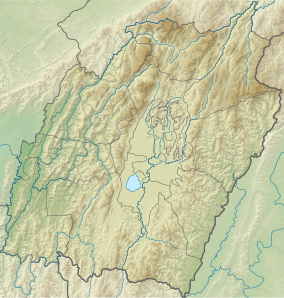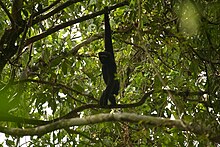| Yangoupokpi-Lokchao Wildlife Sanctuary | |
|---|---|
| (Meitei: Yangoupokpi-Lokchao Lamlak-ki Saa-Ngaa Ngaak Senpham) | |
 Purple Sapphire (Heliophorus epicles) in the Yangoupokpi-Lokchao Wildlife Sanctuary, Manipur Purple Sapphire (Heliophorus epicles) in the Yangoupokpi-Lokchao Wildlife Sanctuary, Manipur | |
  | |
| Location | Chandel district, Manipur |
| Nearest city | Imphal |
| Coordinates | 24°19′N 94°14′E / 24.32°N 94.23°E / 24.32; 94.23 |
| Area | 184.80 km (71.35 sq mi) |
| Established | 1989 |
| Governing body | Government of Manipur |
Yangoupokpi-Lokchao Wildlife Sanctuary (Meitei: Yangoupokpi-Lokchao Lamlak-ki Saa-Ngaa Ngaak Senpham) is an Indo-Burma wildlife sanctuary in Chandel district of Manipur. It is in the Indo-Myanmar border about 110 km from Imphal. It has an area of 184.80 square kilometers.
The ecosystem of this wildlife sanctuary is unique and vibrant. It represents the Indo-Myanmar biological diversity (Indo-Burma). It is because of the strategic location of the wildlife sanctuary in the meeting point of the two major geographical zones, India and Myanmar (Burma).
History
Yangoupokpi-Lokchao Wildlife Sanctuary was established in the year 1989.
Fauna

Hoolock gibbon (Meitei: "Yongmoo" or "Yongmu") is the only ape species found in India. It lives in this wildlife sanctuary. Others include wild bear (Meitei: Lamlakki Sawom), Himalayan Black Bear (Meitei: Himalayagi Amuba Sawom), Malayan Sun Bear (Meitei: Malayagi Numit Sawom), Slow loris (Meitei: "Yong Ikaithibi") or (Meitei: "Loudraubi"), Stump-tailed macaque, Serow, Indian Civet cat, Common otter (Eurasian otter), pangolin, leopard (Meitei: Kabokkei). Sometimes, elephants (Meitei: Shamu) also migrated from the Indo-Myanmar border.
Visiting seasons
The best season to visit the sanctuary is from October to April. The best time to visit is during the early morning.
Rest houses
There are some rest houses in and around the sanctuary. These are: (1) Forest Rest House, Moreh, (2) Indo-Myanmar Trade Center Rest House, Moreh, (3) Transit Camp at Wildlife Office, Moreh.
See also
- Imphal Peace Museum
- INA War Museum
- Kakching Garden
- Keibul Lamjao National Park - world's only floating national park in Manipur, India
- Khonghampat Orchidarium
- Loktak Folklore Museum
- Manipur State Museum
- Manipur Zoological Garden
- Mizoram–Manipur–Kachin rain forests
- Phumdi - Floating biomasses in Manipur, India
- Sekta Archaeological Living Museum
References
- Singh, Arambam Sanatomba (2021-06-18). Ecotourism Development Ventures in Manipur: Green Skill Development and Livelihood Mission. Walnut Publication. p. 107. ISBN 978-93-91145-59-0.
- SAHA, GOUTAM KUMAR; MAZUMDAR, SUBHENDU (2017-07-01). WILDLIFE BIOLOGY : AN INDIAN PERSPECTIVE (in Arabic). PHI Learning Pvt. Ltd. ISBN 978-81-203-5313-8.
- Singh, Arambam Sanatomba (2021-01-04). Challenges of Climate Change in Manipur: Strategies and Action Plans. Walnut Publication. ISBN 978-1-954399-41-9.
- ^ Singh, Arambam Sanatomba (2021-06-18). Ecotourism Development Ventures in Manipur: Green Skill Development and Livelihood Mission. Walnut Publication. p. 108. ISBN 978-93-91145-59-0.
- Sangeetha, Jeyabalan; Thangadurai, Devarajan; Ching, Goh Hong; Islam, Saher (2019-04-30). Biodiversity and Conservation: Characterization and Utilization of Plants, Microbes and Natural Resources for Sustainable Development and Ecosystem Management. CRC Press. ISBN 978-0-429-75906-2.
- Ghosh, Joydeep (2019-02-28). General Knowledge of Northeast India: For All Psc and Competitive Exams. Educreation Publishing.
- K.P, Laladhas; Oommen, Oommen V.; P.R, Sudhakaran (2015-03-06). Biodiversity Conservation - Challenges for the Future. Bentham Science Publishers. ISBN 978-1-68108-021-5.
External links
- Yangoupokpi - Lokchao Wildlife Sanctuary - datazone.birdlife.org
- Yangoupokpi Lokchao Wild life Sanctuary - e-pao.net
- ‘Sounds of wildlife no longer heard at Yangoupokpi Lokchao in Tengnoupal’ - www.ifp.co.in
- Yangoupokpi sanctuary under threat - www.thesangaiexpress.com
- Yangoupokpi-Lokchao Wildlife Sanctuary - kanglaonline.com